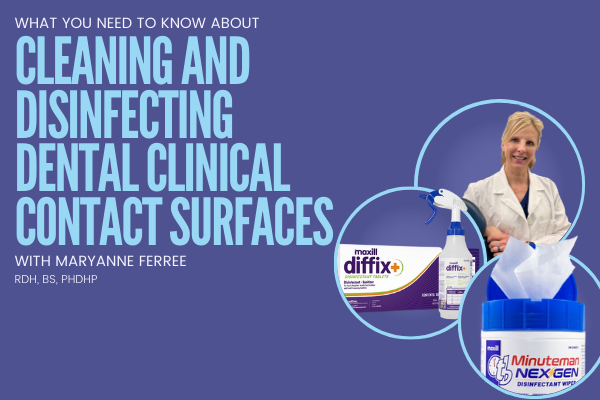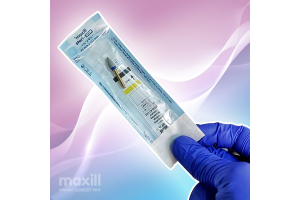What You Need To Know About Cleaning and Disinfecting Dental Clinical Contact Surfaces (While Protecting Your Investment)

A few blogs ago, we talked about the staggering costs of operating a dental practice. Everything from burs, handpieces, instruments, and dental chairs needs appropriate maintenance and adherence to proper cleaning and disinfecting procedures to ensure patient safety and equipment durability. A dental chair and other clinical contact surfaces such as countertops, bracket trays, and lights can become contaminated by pathogens from an infected individual and are a significant cause of healthcare-associated infections. Surfaces can become contaminated through touch, splash, or spray during patient care. A few common pathogens that we routinely encounter in the oral environment, such as staph, can persist for 7 days to 7 months in our dental environment. Certain strains of Streptococcus bacteria can survive for 24 hours to 6 months on improperly cleaned and disinfected surfaces1. Just because a surface is cleaned does not mean that it is disinfected.
Related: Your Complete Guild To Care for Dental Chairs
The Difference Between Cleaning and Disinfection:
- Cleaning involves removing visible soil from objects and surfaces and is customarily accomplished using detergent and water. We need to do a thorough cleaning before disinfection or sterilization because any soil or bioburden that remains on surfaces interferes with the effectiveness of the disinfection or sterilization processes.
- Disinfection is a process that eliminates most pathogenic microorganisms except for bacterial spores on environmental surfaces. The keyword here is most; disinfection is not sterilization which kills all microorganisms. We cannot fit our dental chairs into the autoclave, so we must find ways to disinfect this surface without sacrificing the product's integrity.
Cleaning and Disinfecting Dental Clinical Contact Surfaces
As oral health professionals, it's our responsibility to keep dental clinical contact surfaces clean and disinfected. At the same time, oral health professionals have a substantial investment in dental office equipment that they don't want to destroy with harsh chemicals. This is why it's important to look for cleaning and disinfecting products that meet or exceed IPAC standards and are also gentle enough to use on equipment. You can definitely have the best of both IPAC best practices and investment protection. But to have the best of both worlds, it's important to understand the recommendations for environmental infection prevention and control and what your options for meeting, and exceeding, those standards are.
3 Key Recommendations for Environmental Infection Prevention and Control in Dental Settings2/7
- Establish policies and procedures for routine cleaning and disinfecting environmental surfaces in dental health care settings.
- Use surface barriers to protect clinical contact surfaces, particularly difficult to clean surfaces (e.g., switches on dental chairs, computer equipment), and change surface barriers between patients).
- Clean and disinfect clinical contact surfaces that are not barrier-protected with an EPA or NNHPD approved disinfectant after each patient.
- Select EPA or NNHPD registered disinfectants or detergents/disinfectants with label claims for use in health care settings.
- Follow manufacturer's instructions for use (IFU) of cleaners and disinfectants (e.g., amount, dilution, contact time, safe use, disposal).
Key Recommendations on Chemical Disinfectants in Dental Settings
The CDC and Health Canada recommends that dental healthcare personnel use chemical disinfectants approved by the EPA (Environmental Protection Agency), and FDA (Food and Drug Administration) in the United States, and the Natural and Non-prescription Health Products Directorate (NNHPD) in Canada to disinfect environmental surfaces and equipment 3/7. The EPA and the NNHPD regulate liquid chemicals used on clinical contact surfaces in the healthcare setting. All products registered have warnings, directions for use, and additional information printed on their labels. In the CDC and Health Canada guidelines, only EPA or NNHPD registered chemical disinfectants should be used in the dental setting; therefore, the use of unregistered products is not recommended.4/5 Any chemical you use in a dental office must have a registered claim as tuberculocidal. The tuberculocidal disinfectants are your intermediate-level disinfectants.
Looking for more information on IPAC (Infection Control and Prevention) Resources? Here's a link to our extensive list of PDF checklists and informational articles!
The 3 Different Levels of Chemical Disinfectants
The CDC, FDA, and Health Canada categorize chemical disinfectants as high-level, intermediate-level, and low-level based on the ability of the disinfectant to destroy or inactivate pathogens3/7
- High-level disinfectants destroy all microorganisms but not all bacterial spores; these disinfectants are used to immerse heat-sensitive items; they are not to be used on environmental surfaces. They are very toxic and require special precautions for use. One example is glutaraldehyde.
- Low-level disinfectants inactivate HIV, staph aureus, pneumonia, and salmonella. Still, we know we can contact more virulent microorganisms that are more difficult to kill in our dental offices, especially viruses such as rhinovirus and any new emergent viruses.
- Intermediate-level disinfectants destroy most fungi and viruses. It kills the bacteria that cause tuberculosis. Although TB is spread through airborne droplets and not by contaminated surfaces, the ability to kill this TB bacteria is used as a benchmark to measure how effectively a disinfectant will kill microorganisms. TB is a very difficult organism to kill, only bacterial spores are more challenging, and the only safe and efficient method to kill bacterial spores is sterilization by autoclave.
Cleaning and Disinfecting VS Barriers in Dental Settings
When cleaning and disinfecting, keep in mind:
- Some product formulations combine the detergent and a disinfectant as the active ingredient. if you use a cleaner/disinfectant product, it is imperative that if you are using a spray disinfectant, you must spray-wipe-spray or wipe-discard-wipe with pre-moistened wipes.3/7
- Do not mix products formulations
- Check dental equipment and chair upholstery manufacturers' recommendations for specific products that do not adversely affect the equipment or surface. When it comes to dental equipment, not all products are the same. Each equipment manufacturer has performed material compatibility tests on their equipment and issues their maintenance recommendations in the instructions for use (IFU) document. This instruction document should accompany every piece of dental equipment in your office.
- When changing products, you must thoroughly wash all environmental surfaces with soap and water to remove residual disinfectant chemicals before using a new product.
When using barriers, keep in mind:
- The purpose of surface barriers is to prevent direct and indirect contamination of the surface or equipment and reduce the need to clean and disinfect that surface or equipment before reusing 3/7
- The use of barriers prolongs our equipment and makes cleaning and disinfection easier.
- Barrier protection is the most efficient way to protect difficult-to-clean, electronic, frequently touched or smaller surfaces.
- Barriers also protect surfaces that could be degraded, such as the vinyl on dental chairs, which should be protected from the frequent or improper chemical application.
- Use barriers on as many surfaces as possible.
- There are a variety of barriers available from your dental supply company.
- Any barrier material chosen for use on clinical contact surfaces must be single-use and resist moisture and fluid.
- You should never remove used barriers without being gloved
- At the end of the day, every clinical contact surface, regardless of if barriers are used, should be cleaned and disinfected with an EPA-registered hospital disinfectant
Proper cleaning and disinfecting of clinical contact surfaces ensure that pathogens will not spread to ourselves or our patients and extend our dental equipment investment.
maxill is a global leader in Dental Infection Control Products. Check out our broad spectrum of cleaners and disinfectants.
References:
- Schneiderman, M. T., & Cartee, D. L. (2019). Surface Disinfection. Infection Control in the Dental Office: A Global Perspective, 169–191. https://doi.org/10.1007/978-3-030-30085-2_12
- Centers for Disease Control and Prevention. Summary of Infection Prevention Practices in Dental Settings: Basic Expectations for Safe Care. Atlanta, GA: Centers for Disease Control and Prevention, US Dept. of Health and Human Services; October 2016. http://www.cdc.gov/oralhealth/infectioncontrol/guidelines/
- Centers for Disease Control and Prevention. Cleaning and Disinfecting environmental surfaces. March 25, 2016. https://www.cdc.gov/oralhealth/infectioncontrol/questions/cleaning-disinfecting-environmental-surfaces.html.
- United States: Environmental Protection Agency (EPA) list of registered hospital-grade disinfectants. Available at: www.epa.gov/pesticide-registration/selected-epa-registered-disinfectants.
- Canada: IPAC Canada Buyers Guild: https://ipac-canada.org/buyers-guide-and-products.php
- Natural and Non-prescription Health Products Directorate (NNHPD). Available At: https://www.canada.ca/en/health-canada/corporate/about-health-canada/branches-agencies/health-products-food-branch/natural-non-prescription-health-products-directorate.html
- Oral Health Care Worker: Guidelines for Infection Prevention and Control in the Dental Office. Available at: https://www.picnet.ca/wp-content/uploads/RCDSO_Guidelines_Infection_Prevention_and_Control.pdf







